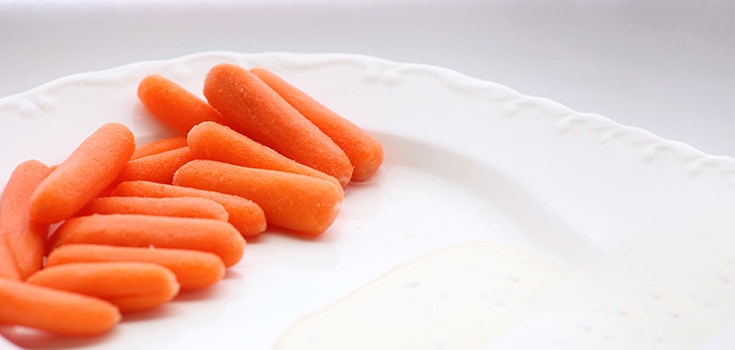How Are Baby Carrots Made?

How are baby carrots made? While obvious to some, many people may not know that baby carrots are not naturally occurring. What you may also find surprising is that these carrots aren’t genetically modified, or even grown/harvested specifically to be small. Showing one farmer’s creative thinking, and society’s desire to have the perfect looking food, the story behind baby carrots is indeed an interesting one.
How Are Baby Carrots Made?
Nearly everyone who eats baby carrots eventually thinks: how are baby carrots made? Baby carrots are actually cuttings of fully grown carrots that have been cut and peeled to make that ever-so-popular baby-cut style. The idea of baby carrots came about when a California farmer named Mike Yurosek was tired of throwing away slightly rotted, deformed, or imperfect carrots that didn’t catch the public’s eye. It seems that if a carrot showed any signs of being knobby, twisted, or broken, it isn’t worth eating. In fact, some farmers like Yurosek would have to throw 400 tons of carrots down the cull shoot each day because they wouldn’t sell.
Culls are carrots that are too twisted, knobby, bent or broken to sell. In some loads, as many as 70% of carrots were tossed. And there are only so many discarded carrots you can feed to a pig or a steer, says Yurosek, now 82 and retired. “After that, their fat turns orange,” he says.
The idea was cultivated in 1986, when Yurosek began selling these baby carrots in stores. Stores paid 10 cents a bag for whole carrots and sold them for 17 cents, while paying 50 cents for a 1-pound package of baby carrots and selling them for $1. By 1989, more markets were on board, and the baby carrots continued to be an economic powerhouse. The idea was a great one – being able to utilize food that would otherwise be wasted and tossed, and all without the questionable method of genetic engineering.
Of course there is always a downside. While baby carrots are convenient, they are more expensive than normal carrots and lack taste and flavor. In addition, the success of baby carrots may be a reflection of the desire for food to be uniform in appearance and taste, and for food that is sterile, prewashed, and prepackaged.
Additional Sources:

dont they have bleach in them or somethin?
They are bleached,thats why they are white in color.Cancer in a little bag!
Now if I were a processor looking for added profits, i would definitely send rotten carrots to the hogs.
However, knowing how they peal potatoes, yes, with an 'e', I would filter the residue from the 'peeling' (shrinking to make 'em babies) process, and package and sell it as an edible element to food processors as a flavoring, thickening or filler. A tweeking of the cleaning process to remove dirt and unwanted elements is easy.
I am sure there may be more money in that, than as a hog feed. Maybe that is already being done we just don't know it.
A picture is worth a thousand words.
The carrots are pumped using chlorinated water throughout the manufacturing process. However, the chlorine level in the water is monitored on a half hour basis and is kept to a minimum. There is an obvious reason for chlorinating the water. Sterility, as peeled carrots are sold as edible out of the bag. The 2nd reason, which is less obvious is due to the cooling process of the cut and peeled finished product. The core temp in a baby carrot must be below 36° to prevent sliming while in the bag. Chlorine Dioxide is a prevalent chemical used in the cooking process, and thus, winds up in the product flow. The cooling process is not only essential for a long lasting fresh product, but also consider the environment mos edible carrots are grown in (nearly all carrots eaten in the US are grown either in California or Washington). These are farmed in California's more arid (really f'n hot) climates and therefore need to be cooled in order to provide nation (us), as well as quite a few countries, with most of their carrot consumption. The chlorine is an essential part o the process, otherwise companies would not be able to sell carrots statewide, let alone nationwide. All in all, the chlorine is minimal, but is a benefactor for keeping carrots fresh. BTW, the organic carrots taste better and mask the chlorine better.
Also, carrot manufacturing is a perfect example of efficiency of farming. Every ounce of carrot gets used. Bad carrots get juiced where the bad parts are sorted out, scraps get either juiced or used to make carrot concentrate which is a huge product overseas, especially Japan (they make terrible sodas and sweetened drinks with them), an over and undersized carrots (ones not found in a baby carrot bag) are used to make various cuts of carrots suck as match sticks, chips, etc (crap you find in salad).
Hope this is enlightening. Enjoy your carrots. The best ones are grown in Washington state, which are harvested from July to November.
Oh NO , the best ones are grown in Foxton New Zealand, by the organic grower family Jones. Lots of Love from N.Z. Angelika